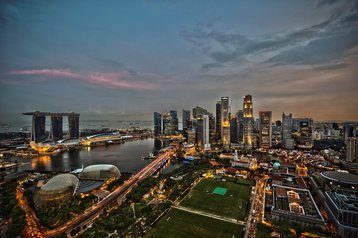To describe the global economic disruption caused by Covid-19 as massive is an understatement. As we continue to witness, businesses are still taking part in the greatest work-from-home experiment ever or finding their footing under this constantly-changing “new normal." It is without a doubt that the entire business landscape, regardless of industry, has been redefined because of the pandemic.
Fortunately, as with every bad situation, there are always silver linings we can look at and in this case, it would be a digital one. According to McKinsey & Company, companies digitalized 20 to 25 times faster during the pandemic. Businesses that we thought would never go online ended up doing so and the demand for digital entertainment is at an all-time high. In the years to come, this will surely be the milestone event that gave our digital economy a major boost.
As the backbones of our digital economy, these are three areas that will take center stage in APAC’s data center and cloud industry as we enter the new year – one that would likely see the digital economy take shape fully.
The need for a multi-local approach
While data sovereignty conversations have been happening across the region in recent years, 2021 will be the year governments step up their involvement, particularly from a regulations point of view. This comes after the pandemic incurred data explosion and the inevitable arrival of 5G around the region. The increased awareness and understanding of data as an asset will force governments to introduce new regulations or update current ones on a local level and in turn, increasing operational complexity for data center and cloud players. While still evolving, some of the regulations were created with these purposes in mind:
- A matter of national security that requires access to data like the US’s Cloud Act
- Protecting data privacy with a focus on users and customers like Singapore’s Personal Data Protection Commission and Europe’s General Data Protection Regulation
- To have technological sovereignty, protect their market and develop a regional ecosystem like in China
Regardless, there is a need for the data center and cloud industries to adopt a multi-local approach and adapt to differing local regulations in order to succeed.
One likely direction would be the establishment of edge data centers or mini data centers. On top of meeting local data regulations, these new data centers will also serve the need to reduce latency and bring out new usages especially in combination with 5G for a low latency network. Such an approach would result in the establishment of a model in which regional hyperscale data centers in one country will connect to smaller data centers in another country. The ASEAN model, for example, is one where Singapore could host a hyperscale data center that is connected to smaller data centers in countries like Indonesia meant to support specific local industries that have data localization requirements.
Zooming into the cloud industry, the difference in the cloud players’ technology offerings will become more obvious. While the major US players look to acquire technologies and consolidate their portfolio of solutions, others are looking to build an open ecosystem where customers have the choice of choosing the technologies they deploy – making the evaluation of cloud and data center partners a success determining process for businesses.
Sustainability as an industrial responsibility
While it is true the digital surge has caused a rise in overall consumption this year, it would be premature to say the same would happen in 2021. In fact, there are many reasons to believe that overall consumption would be better offset next year despite the expected increase.
In a bid to limit environmental impact of the data center and cloud industry, providers are slowly shifting away from air-conditioning and embracing water or immersive cooling as it becomes the de facto cooling mechanism in 2021. Hyperscalers have been investing heavily in R&D for immersive or water cooling in recent years. This is considered a significant breakthrough because just 15 years ago, almost no hyperscalers thought it would be possible especially with the inherent risk water has on services and data, with the exception of one or two who started on R&D efforts.
In addition, research on the possible use of green technologies such as wind and solar farms in this region will continue in 2021. There are many reasons to be optimistic about this with numerous successful implementations in Europe and huge regional projects that are potential game-changers. For example, the Sun Cable project which will see solar energy transmit from Northern Territory, Australia to Singapore, targeting to provide up to 20 percent of Singapore’s electricity demand and eventually reaching Indonesia by end-2027.
The Rise of AI
The rapid advancement and adoption of AI is well documented and increasingly visible especially in the consumer sphere with the use of digital assistants, facial recognition and social media bots. Such a strong momentum will continue in 2021 on the corporate side with governments and businesses across industries increasing their reliance on AI to predict the unpredictable, especially having experienced the amount of disruption the pandemic has caused. In light of this, it will be a norm for cloud providers to incorporate AI offerings in their cloud solutions on top of educating organizations on best practices to utilize such a powerful technology – leading to the democratization of it. AI is also set to play a larger role in helping businesses mine a massive amount of data for insights and predictive analysis.
Due to its inherently resource-intensive nature, data center providers will be looking to increase their capacity of dedicated servers for AI and machine learning be it bare metal, cloud solutions or a hybrid of both.
The future is still bright
Although there is no denying that the pandemic has impacted the economy globally this year, I firmly believe APAC will be one of the regions that recovers the fastest.
Over the years, APAC has proven its resilience and reputation as a digitalization machine with its nations understanding the importance of technology and embracing it wholeheartedly.
Exciting times await the region and one area that would help businesses gain the upper hand over competitors lies in their ability to find cloud and data center partners that are able to empower them towards their business objectives on a local, regional and international level. The best providers are those that enable organizations to innovate for freedom with no restrictions on their choice of digital solutions while offering data reversibility and an open ecosystem.





